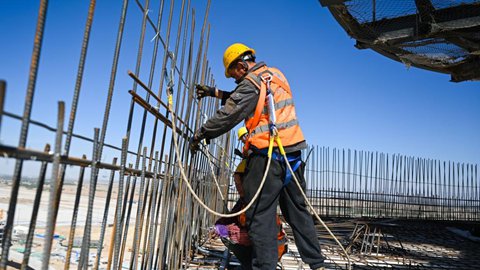BEIJING, May 10 (Xinhua) -- China's economy is expected to maintain its recovery momentum despite multiple challenges, as evidenced by the favorable performance of numerous key indicators, experts said.
A prime example is the most recent release of China's foreign trade data. Despite the challenges, such as the high base effect and currency depreciation pressure, China's total goods imports and exports expanded 2.2 percent year on year in U.S. dollar terms in the first four months of this year, data from the General Administration of Customs (GAC) shows.
In yuan terms, China's total goods imports and exports expanded 5.7 percent year on year during the period, stronger than the 5 percent recorded in the first quarter (Q1) and reaching a new high in the same period in history, according to the GAC.
Structurally, China's export portfolio has demonstrated strength in the sectors of ships, electric vehicles and construction machinery, with growth rates of 108.4 percent, 28.3 percent and 16.2 percent, respectively.
This stellar foreign trade data aligns with the overall positive trend seen across various data. In Q1, the country's foreign trade cargo throughput at major ports climbed 9.5 percent from the same period last year, while the number of twenty-foot equivalent units (TEUs) of containers handled by these ports jumped 10 percent year on year.
Zhang Xiaotao, dean of the school of international economics and trade at the Central University of Finance and Economics, said the vigorous performance in foreign trade signified the continuous effectiveness of the supportive macroeconomic policy mix.
The quantitative and qualitative growth in foreign trade will bolster confidence and provide impetus for economic growth, Zhang added.
Since the beginning of the year, the Chinese government has leveraged a variety of policies to cope with various challenges, such as insufficient demand, high operation pressure facing enterprises, and an external environment that is more complicated, grimmer and more uncertain.
These initiatives encompass strengthening financial and fiscal support for the real economy, promoting a new round of large-scale equipment renewals and trade-ins of consumer goods to stimulate consumption, and proposing new measures to incentivize foreign investment.
The first quarter demonstrated the effectiveness of these efforts. The country's gross domestic product (GDP) grew by 5.3 percent year-on-year in the first quarter of 2024, beating the growth target of around 5 percent set for the entire year.
Supporting the recovery narrative, April's manufacturing purchasing managers' index reading has remained in expansion for two consecutive months, serving as testament to the enhanced market confidence in this regard.
Moreover, industrial enterprises across the country have also experienced strengthened profitability. The profits of China's major industrial firms increased 4.3 percent year on year in Q1, reversing a 2.3-percent decline registered in 2023 and extending an upward trend for three consecutive quarters.
Analysts have also underscored the remarkable growth observed in the burgeoning emerging industries, as the country's attempt to nurture the "new quality productive forces" is generating more growth catalysts for the economy.
In Q1, the high-tech manufacturing sector reported robust profit gains, which surged 29.1 percent year on year, reversing from a decline of 8.3 percent registered in 2023. During the period, the production of smart and green products such as 3D printing equipment, service robots and new energy vehicles increased by 40.6 percent, 26.7 percent and 29.2 percent year on year, respectively.
Consumption has emerged as a bright spot, significantly contributing to domestic demand and overall economic growth. Data from the National Bureau of Statistics shows that retail sales of consumer goods, a major indicator of the country's consumption strength, climbed 4.7 percent year on year in Q1.
The enthusiasm for travel during the just-concluded five day May Day holiday exemplifies China's strong consumption demand. Data from the Ministry of Culture and Tourism shows about 295 million domestic tourist trips were made during the holiday, up 28.2 percent from the same period in 2019. Domestic tourist expenditure during the period totaled 166.89 billion yuan (about 23.5 billion U.S. dollars), up 13.5 percent from the same period in 2019.
Global tourist destinations saw a surge in popularity among Chinese holidaymakers. The volume of overseas hotel bookings rose about 100 percent year on year, while the booking value of overseas car rentals surged three times year on year, according to a report from Fliggy, one of the country's leading travel platforms.
Wang Yiming, vice chairman of the China Center for International Economic Exchanges, emphasized the improvement observed on both the supply and demand sides. Wang noted that with the accumulation of positive factors in China's economy, the trend of economic recovery will further solidify.
Buoyed by the Q1 economic growth, international institutions such as Goldman Sachs and Morgan Stanley have revised upwards their forecasts for China's economic growth this year.
In line with this optimistic outlook, a report released by the Asian Development Bank said that China will contribute 46 percent to the economic growth of developing countries in Asia from 2024 to 2025, retaining its status as the largest growth engine for the world economy.
Looking ahead, experts anticipate that the momentum of recovery is likely to continue into the second quarter of the year, expecting a brightened outlook for the country.
Lian Ping, President of the China Chief Economist Forum, said the stronger-than-expected data performance indicates a robust recovery in China's economy, with enhancements in both internal dynamics and external demand.
Lian predicted that both quarter-on-quarter growth and the two-year average growth rates will accelerate in the second quarter of the year.
"With the solid implementation of supporting policies, the full-year economic growth may surpass the set target," Lian suggested, calling for further steps to implement existing supportive policies. ■











